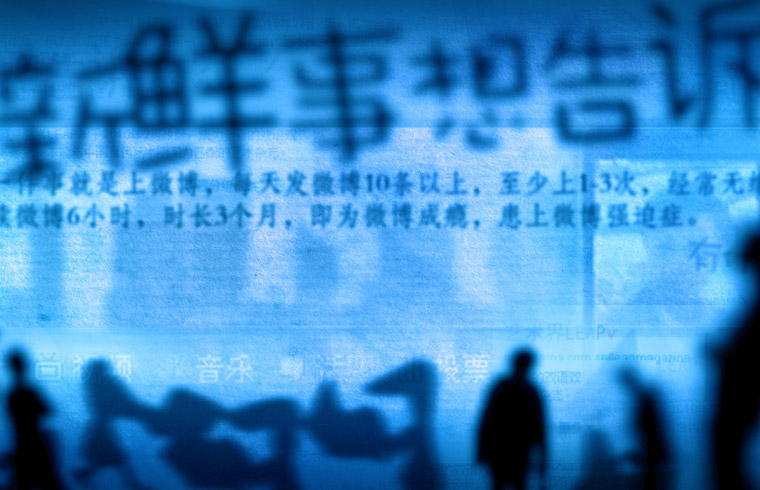MICROBLOGS, MEGA AUDIENCES
| February 11, 2011 | Post In LEAP 7

In 2010, the influence of microblogging on the Chinese art world was, in fact, quite micro, but it has at least become part of the conversation. If used properly, Weibo (literally “microblog,” a Twitter-style service from Chinese web portal Sina) is a tool with the capacity to transform artistic production.
For galleries, microblogging has become a direct platform for publicity. It is also a boon to non-profit public art institutions, which benefit from this kind of free tool for dissemination. In 2010, the number of people following the microblogs of many museums reached into the thousands.
As for art practitioners and theorists, including curators, critics, art historians, and so on, the significance of microblogging is more complex. There is a sharp contradiction between the deep concentration required of art professionals and the hasty, breathless pace of microblogging. Its constant presence is irritating or even overwhelming to some. To many creatives, the synchronic and verbal interface of microblogging interferes with authentic sensory experience; no wonder few artists are prolific microbloggers. But to both artists and theorists, microblogging does in fact provide opportunities for experimentation and inspiration. They can not only gather information, but also engage in exchange. Contemporary art long ago moved passed mere visual and material values, and relational and dialogic aesthetics have already become major topics of artistic exploration. In this exploration, the works of art are often less important than the processes of exchange they stimulate. The reduction of art to visual pleasure and proscribed material forms is outdated and lifeless. Today, artists and theorists from different backgrounds have opportunities to communicate with each other and participate in new globalized social justice movements.
Microblogging provides access to difference and diversity, giving artists opportunities to initiate dialog and learn from others. Effectively organizing one’s own microblog is no different than editing a continuously interactive magazine in which every person one follows is a columnist. Thus microblogs provide opportunities to listen attentively, which is more of an art than drawing conclusions. It is complex, active, and productive. Between listening and answering lie opportunities for the art world’s most insular people to lower their barriers of isolation. Thus, artists can seek creative potential and communal consciousness in the voices of others.
Indeed, the “micro” aspect of microblogging has a certain anti-fascist appeal. The grandiose scale of contemporary art is reflected not only in the measurements of actual artworks but also in artists’ value systems and perspectives on class. Some are seeking high valuations of their work in the commercial art market; others are seeking high valuations of their work in the eyes of art critics and historians; some even seek affirmation in terms of studio space and other material accoutrements. They all want to “go big,” overlooking ordinary audiences— overlooking “micro.” They run the risk of becoming sealed off in forceful, sterile, and “specialized” spaces, providing perspectives on humanity that are limited in their terseness, elegance, and rigidity.
As Stephen Willats instructs in Society through Art, “turn the audience into the theoretical foundation.” As microblogging continues to spread like wildfire, it has the potential to break apart the coagulum of art practitioners and arbiters by helping them enter different groups, experience the lives of others, reflect upon themselves, and shed their fascist uniforms of “taste.”
The effectiveness of microblogging in fighting “art corruption” has also been demonstrated. Recently, a photo emerged of a certain “great master” of traditional Chinese painting simultaneously producing twenty paintings in an assembly-line process. As one of the major stories of 2010, this incident revealed the power of microblogging to expose fraudulent production processes. Corrupt art is like a heinous witch disguised as a beautiful woman; in exposing it, the microblogging world reinforces its legitimate capacity for mass supervision.

In the second half of 2010, as the number of Weibo users continued to skyrocket, the “Weibo art world” gradually gained momentum. In June and July it seemed that every gallery and museum had set up an account and become active in art’s sudden Weibosphere. By the end of October, Sina had a total of over fifty million registered microblog accounts, and Sohu had ten million. In this army of microblogs, the proportion of art-related accounts is miniscule. Sina, for example, divides its real-name authenticated accounts into 17 professions and nearly 140 tags. Under the “painting and calligraphy” tag, you can find Fang Lijun and Zhang Xiaogang; curators have no tag of their own, and must use “collecting.” According to a Sina spokesperson, “the vast majority of Sina microbloggers have only vague ideas about contemporary art,” and there are only around 190 authenticated accounts tagged with “painting and calligraphy” or “collecting.” According to search data, mass-market comedian Zhao Benshan is the most sought-after “artist”; although he has only made eight posts to his microblog and follows only thirteen accounts, he has over 640,000 followers, far surpassing Fang Lijun’s 70,000 fans.
At Sohu, which places a greater emphasis on personalization, there are roughly 300 core accounts associated with the culture channel and contemporary art. Active users include Zuoxiao Zuzhou, Cui Xiuwen and Chen Ke. According to Li Fang, the editor-in-chief of the culture channel, mainland Chinese microbloggers have habits vastly different from overseas users, who mainly use Twitter. Twitter is primarily used as a tool for social interaction; Twitter users have more diverse tastes and are more likely to write their own posts and follow their friends. China’s microblog users write less and read more, mostly following public figures and celebrities. In the contemporary media environment, microblogging merely supplements mass media: “it’s more like a personalized media.” (Ricky Li)

